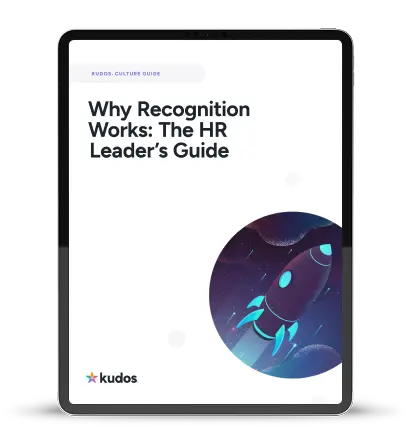The Key to A Winning Employee Recognition Strategy
Recognition
February 9, 2023
Margaux Morgante
X min
Recognition
February 9, 2023
Margaux Morgante
X min

This article was originally published on HR.com
Employee recognition is an age-old practice dating back to the Industrial Revolution when employers sought to make employees more efficient at work. While much has changed since then in terms of management styles, organizational structures, and workplaces (the last one especially, given the last two years) – many organizations still haven’t adapted their recognition practices to meet changing employee expectations, relying instead on dated, rewards-focused, infrequent recognition for a select few employees.
Employee recognition is a powerful tool that, when used correctly, leads to better employee engagement, improved organizational performance, and reduced turnover, among many other benefits (Gallup).
So, how can you modernize employee recognition at your organization this year?
As Muni Boga, President and CEO of Kudos®, a popular employee recognition platform, put it, “it’s not as simple as getting your managers to check recognition off their to-do lists – it’s about building a culture of recognition, where recognition has a deep-seated place in your organization.
Ideally, its value is understood by your people so that it can flow freely and frequently across all areas of your workplace.”Here are some key things to consider when building your strategy:
Historically, employee recognition used to be the responsibility of leaders and managers, or what many know as a top-down approach. Managers would highlight “top performers,” leaving many employees feeling passed over and unappreciated. On the other hand, enabling and encouraging peer-to-peer recognition allows for the democratization of recognition. This approach is not unlike 360 performance evaluation that boomed in the last two decades.
When employees of all levels are empowered to recognize – and receive recognition from – colleagues in all directions (up, down, laterally), organizations see increased employee engagement, reduced turnover, and improved productivity. A study quoted by Gallup found that 66% of employees agreed with the statement, “If I get recognition, I would also like to give others recognition,” the impact is exponential.
Studies have shown that teams that share recognition often create oxytocin responses in their team members, which was strongly correlated to more productivity, innovation, and better work enjoyment ratings.
We’ve all experienced the effects of the Great Resignation. In the 2021 Bureau of Labor Statistics report, the overall turnover rate in the US was 57.3%, but that number drops to 25% when considering only voluntary turnover. That still means a staggering 1 in 4 employees left their job voluntarily in 2021.
Interestingly, studies show that globally, only 1 in 4 employees report receiving recognition in the last week. The urgency to build recognition into daily life at work is evident. Gallup believes that shifting the dial and moving from 1 in 4 having received recognition, to 3 in 5 would deliver employers a 28% improvement in quality of work and a 31% decrease in absenteeism rates.
Another significant trend here is revisiting milestones and anniversaries.
With such high turnover rates in the market, employers should celebrate anniversaries from the first year, recognizing loyalty and hard work. Anniversaries can also be used as a retention tool, incentivizing employees to stay with bonuses at each annual milestone (please, no mantel clocks – see next point).
While recognition itself carries many benefits, it often comes hand-in-hand with rewards. The days of rewarding employees with wildly expensive company pens are gone (or at least, they should be). More and more organizations have realized that historic one-size-fits-all approaches no longer cut it; this is evident through the prevalence of flexible work schedules, remote work, and discretionary health care spending accounts.
You hire employees for their unique skills and individuality – why aren't you factoring that into your rewards strategy? One way to do this is to allow employees to choose gift cards for popular retailers or vouchers for local businesses of their choice. This approach is simple, yet it tells your people that the reward is truly for them, which has a more significant impact.
Who says work and fun don’t mix? Gamification is an incredibly efficient but sometimes forgotten lever that you can use to encourage engagement in building your culture of recognition. Some friendly competition can help kick-start a sustainable habit of free-flowing recognition in your organization. Gamification expert Yu-Kai Chou shares dozens of gamification examples for you to sift through here.
This is why many modern recognition platforms have leaderboards for both recognition received, and recognition sent to spark everyone’s inner competitor. This philosophy isn’t new – the age-old employee of the month award is a great example. The difference is, when the person sharing the most recognition is the one crowned, everyone wins.
Sometimes, the best way to recognize someone is by presenting them with the opportunity to take on more responsibility via a well-deserved promotion. Publicly acknowledging dedication and hard work via a promotion can lead to higher employee retention and engagement. It shows employees that their efforts will be rewarded, and their careers can flourish with your company (Forbes).
There are many benefits to internal promotions beyond morale, such as reduced recruitment costs and less downtime in open roles. As we migrate to more distributed workplaces, identifying top performers may not be as easy as it once was. A recognition platform can be a great tool in this instance, allowing the organizational leaders to easily see who is receiving consistent positive praise from peers at every level.
You can’t manage what you can’t measure. Most HR professionals know by now that employees don’t leave companies – they leave managers. Keeping a pulse on employee-manager relationships can be tricky, but recognition can serve as a lens into your employee experience at all levels. Some of the most sophisticated recognition platforms provide dashboards that illustrate who is giving and receiving recognition, who stands out, and who might be left behind.
Analytics can also help HR leaders demonstrate the value of recognition to their finance and leadership teams to secure the budget they need to develop a robust program.
As Muni Boga from Kudos explains, “the ROI of employee recognition can be significant in terms of recognition’s ability to improve absenteeism and turnover. An organization’s bottom line can dramatically improve not just in terms of those metrics, but also through the impact of those metrics on your organization’s productivity and innovation. Today, in a world where ESG and DEIB measurement is necessary and needed, recognition also plays an important role in illustrating social impact and inclusion.”
In 2022, an employee recognition strategy is a must-have. Building a culture of recognition is not a simple task, but it pays big dividends if it’s approached in the way your employees want.

A newsletter with the best resources for HR professionals.


Propel your organization into new realms by building a culture of recognition that enhances morale and boosts performance across all levels.
Get Your Guide